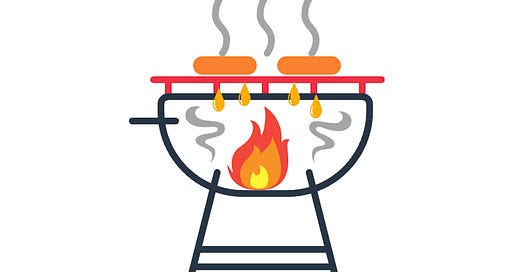If you're like me and find yourself thinking "Wait, wait, don't tell me!" during trivia, keep an eye out for this emoji: 🤔. It’s your cue that the answer is just below. So scroll slowly—when you see that thinking face, the reveal is right underneath.
1. True or False: Browning from the Maillard reaction and charring are the same thing.
🤔
Answer: False
Explanation: The golden brown color derived from the Maillard reaction gives you flavor. Charring gives you… regrets. Golden brown is the goal. Blackened is a warning sign. (Source: “Grill Marks or Warning Signs?”)
2. Which cooking method is most likely to produce HCAs (heterocyclic amines)?
A) Boiling
B) Steaming
C) Grilling meat over high heat
D) Roasting vegetables
🤔
Answer: C
Explanation: HCAs form when high heat comes into contact with meat. It’s a sizzle-and-char situation with unintended consequences. Steamed broccoli, on the other hand, is as boring as it is safe. (Source: “Grill Marks or Warning Signs?”)
3. What leads to the formation of PAHs?
A) Smoke
B) Fire
C) Water
D) Oil
🤔
Answer: A
Explanation: Smoke is the delivery system for PAHs, coating the surface of your food like a potential carcinogenic mist. (Source: “Grill Marks or Warning Signs?”)
4. What’s the main concern with HCAs and PAHs?
A) They lower immunity
B) They can damage DNA
C) They carry bacteria
D) They’re high in sodium
🤔
Answer: B
Explanation: HCAs and PAHs are mutagenic—they mess with your DNA, raising long-term cancer risk. When fat hits flame, those smoke signals carry more than just aroma. (Source: “Grill Marks or Warning Signs?”)
5. Why are vegetables a safer bet on the grill?
A) They don’t contain creatine
B) They cook faster
C) They contain fiber
D) They’re never grilled
🤔
Answer: A
Explanation: HCAs need creatine to form—and plants don’t have it. So char your zucchini without fear of chemical consequences. (Source: “Grill Marks or Warning Signs?”)
6. Which tip helps reduce harmful compounds when grilling?
A) Use a meat thermometer
B) Avoid flare-ups
C) Always close the lid
D) Cook only with butter
🤔
Answer: B
Explanation: Flare-ups lead to char and smoke. Keep a spray bottle handy and treat fire like a seasoning: a little goes a long way. (Source: “Grill Marks or Warning Signs?”)
7. True or False: Burning food preserves flavor.
🤔
Answer: False
Explanation: Charred to the point of no return? That’s carbon, not complexity. Instagram might love it—your gut does not. (Source: “Grill Marks or Warning Signs?”)
8. Why might a cook trim the charred bits off chicken?
A) To reduce bitterness
B) To reduce HCAs
C) To impress guests
D) To make room for sauce
🤔
Answer: B
Explanation: It’s not just aesthetics. Cutting off char may reduce potential carcinogens. (Source: “Grill Marks or Warning Signs?”)
9. What happens when you reheat grilled meat?
A) PAHs disappear
B) Protein increases
C) HCAs stay put
D) It becomes safer
🤔
Answer: C
Explanation: Reheating might make it warm, but those HCAs? Already baked in. The microwave doesn’t undo that chemistry. (Source: “Grill Marks or Warning Signs?”)
10. What’s the bottom line on grilling and health?
A) Never grill again
B) Grilled food is toxic
C) Enjoy it—just grill smart
D) Eat only raw vegetables
🤔
Answer: C
Explanation: Grilling isn’t the enemy. High heat and poor technique are. Keep your eye on the fat drips, keep a water spray bottle on hand, marinate or baste with rosemary, trim the char, and maybe throw on a few vegetables. (Source: “Grill Marks or Warning Signs?”)
So, how did you do?
🤩 Whoa! (9–10 correct)
You’re basically a PhD in nutrition.
Top of the class. No notes.
😐 Meh (5–8 correct)
You know just enough to be dangerous.
A few things stuck, but you might be mixing up sodium with selenium.
😬 Ugh (0–4 correct)
You’re slacking.
Did you eat breakfast today? Maybe try again after a snack.
Tomorrow’s topic...
Protein






